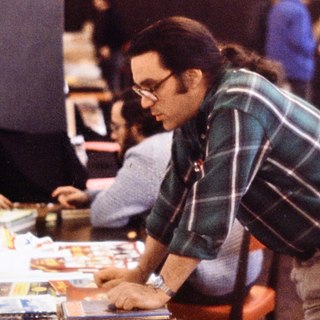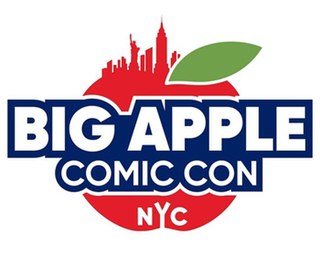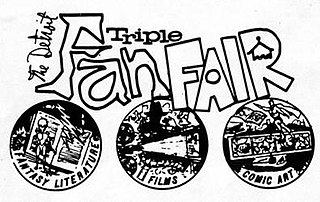
Fredric Wertham was a German-American psychiatrist and author. Wertham had an early reputation as a progressive psychiatrist who treated poor black patients at his Lafargue Clinic at a time of heightened discrimination in urban mental health practice. Wertham also authored a definitive textbook on the brain, and his institutional stressor findings were cited when courts overturned multiple segregation statutes, most notably in Brown v. Board of Education.

San Diego Comic-Con International is a comic book convention and nonprofit multi-genre entertainment event held annually in San Diego, California, since 1970. The event's official name, as given on its website, is Comic-Con International: San Diego, but is more commonly known as Comic-Con, the San Diego Comic-Con, or the abbreviation SDCC.

Philip Nicholas Seuling was an American comic book fan convention organizer and comics distributor primarily active in the 1970s. Seuling was the organizer of the annual New York Comic Art Convention, originally held in New York City every July 4 weekend throughout the 1970s. Later, with his Sea Gate Distributors company, Seuling developed the concept of the direct market distribution system for getting comics directly into comic book specialty shops, bypassing the then established newspaper/magazine distributor method, where no choices of title, quantity, or delivery directions were permitted.
The Toronto Comic Con was an annual comic book convention held in Toronto, Ontario, Canada. It started in 2003 and was sold in 2009 to Wizard Entertainment owner Gareb Shamus. It was subsequently relaunched as a Wizard event in 2010. The event has been on hiatus since spring 2012.
Jerry Gwin Bails was an American popular culturist. Known as the "Father of Comic Book Fandom," he was one of the first to approach the comic book field as a subject worthy of academic study, and was a primary force in establishing 1960s comics fandom.
Notable events of 1971 in comics.

The Big Apple Comic Con is a New York City comic book convention, the longest-running comic book/speculative fiction/pop culture convention in New York City. It was started by retailer Michael "Mike Carbo" Carbonaro in March 1996 in the basement of the St. Paul the Apostle Church. During its heyday from 2001 to 2008, the Big Apple Comic Con often featured multiple shows per year, with a large three-day "national" convention held in November, usually held at the Penn Plaza Pavilion. The show was owned by Wizard Entertainment from 2009 to 2013, but was reacquired by Carbonaro in 2014.

Creation Entertainment is an American for-profit entertainment company located in Glendale, California, which produces fan conventions for fans of various films and television series, mainly in the science fiction, horror, and fantasy genres. Creation Entertainment hosts about 20 conventions annually in various locations such as Chicago, Illinois; and Burbank, California. Creation was founded in 1971 by comic book fans Gary Berman and Adam Malin in New York City. Since then, it has organized over 2,300 conventions.
SoonerCon is a fan-run multi-genre convention held annually in Central Oklahoma, founded in Oklahoma City proper before being held in Midwest City from 2013 until 2018 and then Norman, Oklahoma in June 2019 at the vastly larger Embassy Suites Hotel & Convention Center.
William Carl Schelly was an Eisner Award-winning author who chronicled the history of comic books and comic book fandom, and wrote biographies of comic book creators, including Otto Binder, L.B. Cole, Joe Kubert, Harvey Kurtzman, John Stanley, and James Warren as well as silent film comedian Harry Langdon.
Notable events of 1972 in comics.
Notable events of 1973 in comics.
Bud Plant Inc. was a wholesale comics distributor active in the 1970s and 1980s during the growth of the direct market. The company also published a selection of comics and zines during the same period. Starting in 1970 as a mail-order distributor specializing in underground comix, Bud Plant absorbed some of his smaller rivals in the 1980s, and then sold his business to Diamond Comics Distributors in 1988. He still, as Bud Plant's Art Books, sells quality reprints and graphic novels.

The Detroit Triple Fan Fair (DTFF) was a multigenre convention generally held annually in Detroit from 1965 to 1977. It is credited for being one of the first comic book conventions in the United States. The Triple Fan Fair also gave balanced coverage to historic film showings and science fiction literature, in a manner that provided a template for many future convention organizers — most of which have yet to attain the same level of equal service to this sort of linked fan base.
Great Eastern Conventions, Inc. was an entertainment company which produced comic book conventions, most actively during the years 1987-1996. In New York City, the Great Eastern shows filled the gap between the mid-1980s demise of the annual Comic Art Convention and Creation Conventions, and the establishment of promoter Michael Carbonaro's annual Big Apple Comic Con in 1996. From 1993–1995, Great Eastern hosted two New York City shows annually at the Jacob K. Javits Convention Center. In addition to running shows in the Northeastern United States, Great Eastern also ran shows in Georgia, Florida, California, Oregon, Minnesota, and Texas.
Houstoncon was an annual multi-genre fan convention which was held between 1967 and 1982 in Houston, Texas. Houstoncon started out as a member of the Southwesterncon series of regional conventions, but eventually became an independent con. The founders of Houstoncon were Roy Bonario and Marc Schooley; Houston area entrepreneur Ed Blair, Jr. was also a key member of the organizing committee.
The Academy of Comic-Book Fans and Collectors (ACBFC) was the first official organization of comic book enthusiasts and historians. Active during the 1960s, the ACBFC was established by Jerry Bails, the "father of comics fandom". A vital player in the development of comics fandom, the ACBFC brought fans of the medium together, administered the first industry awards, and assisted in the establishment of the first comic book fan conventions.

A comic book convention or comic con is a fan convention with a primary focus on comic books and comic book culture, in which comic book fans gather to meet creators, experts, and each other. Commonly, comic conventions are multi-day events hosted at convention centers, hotels, or college campuses. They feature a wide variety of activities and panels, with a larger number of attendees participating in cosplay than most other types of fan conventions. Comic book conventions are also used as a vehicle for industry, in which publishers, distributors, and retailers represent their comic-related releases. Comic book conventions may be considered derivatives of science-fiction conventions, which began in the late 1930s.
Southwesterncon was a series of regional multi-genre fan conventions held annually in Texas and Oklahoma between 1966 and 1971. On a rotating basis, conventions were held in Dallas ("D-Con"), Houston ("Houstoncon"), and Oklahoma City ("Multicon"). Southwesterncon is credited with being one of the earliest ongoing comic book conventions in the United States.
David A. Kaler is an American writer. He was a primary force in establishing 1960s comic book fandom, particularly through the form of the comics convention. Later, he had a short-lived career as a comics writer for such publishers as Charlton Comics, DC Comics, and Warren Publishing.







